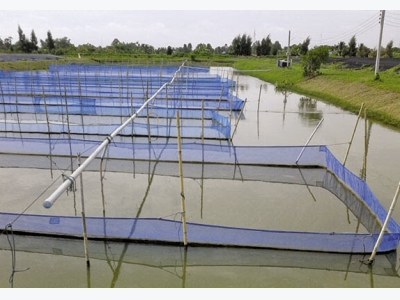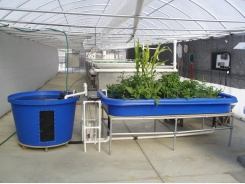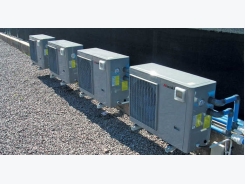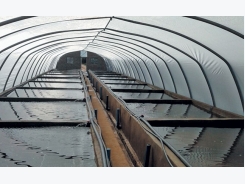Growing fish in salt water

Many argue that tilapia in brackish water taste that little bit better, and it’s difficult to deny this.
Large, grow-out hapas. Photo: Nicolas James
Recently, I discussed the potential of tilapia production in water too saline for other uses. I now want to take a closer look at the technical aspects of such undertakings.
Volumes
Brackish water from low-volume sources can be used in re-circulating tunnel systems identical to those for fresh water. This is your best option if only a borehole supply is available. If you have access to larger volume sources, and are based on the warmer, north-east coast of South Africa, then ponds are an option. Don’t underestimate the amount of water needed to fill earth ponds, and to keep them full.
A half-hectare pond with an average depth of 1m requires five million litres of water to fill it. Using a diesel pump working at a rate of 100 000l/ hour, this would take more than two days to accomplish. If fertilised with chicken manure and managed well, an earth pond of this size can produce approximately 2,5t of tilapia/year.
Fresh to salt
If the fish were bred in fresh water, the fingerlings need to be acclimatised to the brackish water. Direct transfer from fresh to salt water usually results in 100% mortalities. The fingerlings should be kept in fresh water and the salinity gradually increased over 14 days until it matches that of the water in the grow-out facility. This requires containments to hold the fingerlings, coupled to some form of filtration/aeration to keep the water quality high.
Hapas
A valuable tool much used in Asia pond aquaculture is the ‘hapa’. The mesh of these net enclosures is small enough to prevent fish from escaping, while allowing sufficient water exchange to keep the water clean. Hapas of 2m² to 5m² can be used to hold small fingerlings (20mm to 30mm). Larger sizes (100m²) can be used for grow-out. In this way, fish of differing size and age can all be accommodated in the same earth pond.
Sampling/harvesting
Harvesting or sampling the fish is easy with a hapa. Simply slip a pole horizontally under the net and move it along the length of the enclosure, crowding the fish into one end. Hapas extend about 20cm above the water to prevent the fish jumping out.
Protection
Another advantage of a hapa is that it can be covered with netting to prevent birds and other predators from stealing the fish. This is often more practical than covering the entire pond with netting.
Fish to farm
Red tilapia are ideal for brackish water culture, especially in hapas. Mozambique tilapia can thrive in either brackish or full-strength seawater. And finally, it is said that tilapia reared in salt water taste better than those from fresh water. This may be little more than good old South African folklore, but the fact remains that tilapia from such ponds do taste extremely good.
Certainly, there is none of that ‘muddy’ or ‘off’ flavour sometimes associated with fish from farm dams green with algae.
Nicholas James is an ichthyologist and hatchery owner.
Related news
Tools

Phối trộn thức ăn chăn nuôi

Pha dung dịch thủy canh

Định mức cho tôm ăn

Phối trộn phân bón NPK

Xác định tỷ lệ tôm sống

Chuyển đổi đơn vị phân bón

Xác định công suất sục khí

Chuyển đổi đơn vị tôm

Tính diện tích nhà kính

Tính thể tích ao




 The history of the red tilapia
The history of the red tilapia  Aquaculture 101: the advantages of greenhouse tunnels
Aquaculture 101: the advantages of greenhouse tunnels